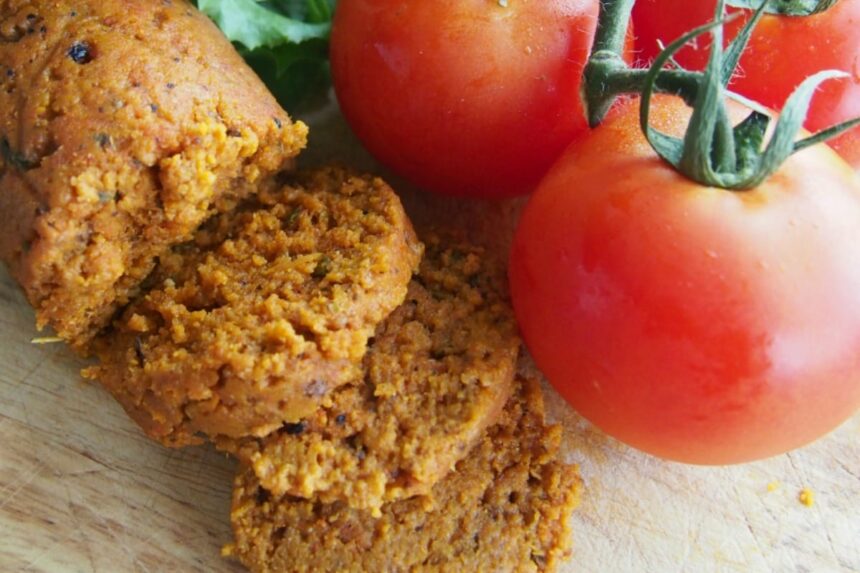Help keep One Green Planet free and independent! Together we can ensure our platform remains a hub for empowering ideas committed to fighting for a sustainable, healthy, and compassionate world. Please support us in keeping our mission strong.
Sausage wasn’t a food I grew up eating, but later on, I learned how delicious sausage was with all its bold spices and flavors. Then I stopped eating meat and sausages were back off the menu. But one day I was at an event at an animal sanctuary and they were serving grilled vegan sausages on rolls with peppers and onions. As I bit into the crisp sausage, I was amazed at how authentic it tasted. Then I became gluten-free and sausages were off the menu yet again. I knew I had to learn how to make my own meatless sausages.
The good news is that it’s easy to make your own plant-based sausages. Sausages that are firm, crisp on the outside and packed with flavor on the inside. Sausages that won’t break or fall apart even on the grill. Sausages that can be shaped into logs or patties and can be sliced … even if they are gluten-free. They can also be seasoned in so many different ways so we can have Italian sausages, chorizo, andouille or breakfast sausages. Here are the tips and tricks you need to make your own plant-based sausages at home.
1. Choose a Base

So you want to make some vegan sausage. The first question is what do you want to make them out of? Just as you can make burgers from a large variety of vegetables, you have lots of choices from which to make sausages. You can make sausages out of tofu, texturized vegetable protein (TVP) or seitan. These Homemade Andouille Sausages are made with tofu while these Spicy Andouille Sausages are made with seitan. Chorizo which is a crumbled sausage can be made with tofu as in this Tofu Chorizo and Lemon Cauliflower Rice, tempeh as in this Butternut Squash Tacos with Vegan Tempeh Chorizo.
You can blend any of those ingredients with lentils or beans or you can make sausages with lentils or beans as the main ingredient. The first time I ever made vegan sausages, I used lentils which have an earthy, meaty taste and texture. When I wanted something more neutral, I turned to beans. Pinto beans are a great choice as are black-eyed peas which are my favorite choice for sausages like my Gluten-Free Spicy Italian Sausages.
Vegetables such as eggplant or mushrooms can also be mixed in to add more flavor. Mushrooms add meaty flavor as in these Soy-Free Glamorgan ‘Sausages’ in Eggplant ‘Bacon’ Wraps while eggplant adds complexity. Eggplant sausage is one of my new favorite ways to make sausage. Just like you can make Carrot Dogs, you can change up the spices to make carrot sausages. There are so many choices. Experiment and see which combinations of flavors you like best.
2. Choose a Flavor

Now that you know what you’re making your sausage from, you need to decide on the flavor profile. Different spice blends can completely change the sausage depending what you’re planning to do with it. Italian dishes need sausages with a different spice blend than do Mexican dishes or breakfast dishes.
Chorizo sausages need a spicy Mexican blend. My chorizo spice blend is red chile powder, garlic powder, dried oregano, paprika, ground cumin, dried thyme, onion powder, ground coriander, black pepper, ground cinnamon, ground allspice, ground turmeric, and cayenne pepper. Then I add a little tamari and red wine vinegar. Or try the chorizo spice blend used to make this Spicy Potato Casserole With Tofu ‘Chorizo.’
Andouille sausage flavors include garlic, salt, pepper, cayenne, chile powder, thyme, allspice, paprika, mace, bay, and sage. Make these Homemade Andouille Sausages or these Spicy Andouille Sausages. Italian sausages combine garlic, fennel, paprika, smoked paprika, red pepper flakes, oregano, salt, pepper, and allspice. Breakfast sausages usually contain dried sage, allspice, marjoram, red pepper flakes, fennel, salt, pepper, and brown sugar. Some may also have maple syrup or pulsed apples in them. Try these Gluten-Free Breakfast Sausages, Breakfast Andouille Sausage with Biscuits, and Classic Breakfast Links.
3. Other Ingredients
![Homemade Andouille Sausages [Vegan, Gluten-Free]](https://i0.wp.com/www.onegreenplanet.org/wp-content/uploads//2015/10/andouille3.jpg?resize=640%2C403&ssl=1)
Besides the spice blends, there are other flavors that need to be added into the sausages. These are the flavors that will give the sausages their meaty, salty, savory tastes – the umami that makes them mouthwatering and delicious. These ingredients might include mushrooms, tomato paste, soy sauce, tamari, miso, ketchup, vegan Worcestershire sauce, balsamic vinegar, red wine vinegar or even caramelized onions. These Smoky Black Bean Sausages use soy sauce and hickory smoke while these Homemade Andouille Sausages use strained tomatoes and nutritional yeast. See Plant-Based Ways to Add Umami in Your Dishes for more on how to add this fifth taste to your recipes.
4. Binding and Chew
![Classic Breakfast Links [Vegan]](https://i0.wp.com/www.onegreenplanet.org/wp-content/uploads//2015/07/Sausage08-1024x683.jpg?resize=640%2C427&ssl=1)
Now that we have added all this flavor and spice to our sausages, we need to do something to make them hold together and have that dense texture and “bite” that you expect from a sausage. Any type of flour can be used to the binding. Vital wheat gluten is usually found in vegan sausage recipes. It not only helps bind the ingredients when the strands of gluten form but it is what gives the sausages their dense, chewy texture. These Vegan Bangers use vital wheat gluten as do these Classic Breakfast Links.
If you are making gluten-free sausages, you can use gluten-free flour. I use brown rice flour in my Spicy Italian Sausages while these Homemade Andouille Sausages use cornmeal and corn flour. For gluten-free sausages, the key to getting that firm texture is xanthan gum or guar gum. These gums are used as thickeners in baking and gravies and they provide the structure that would normally be provided by gluten. A bag of xanthan gum is a bit expensive, but a little bit goes a very long way, so it is well worth the investment.
5. Pick a Shape

The next decision to make is which shape you want your sausages to be. You can make links like my Spicy Italian Sausages, these Classic Breakfast Links or this Homemade Vegan Italian Sausage or you can make patties like this Gluten-Free Breakfast Sausage and these Spicy Sausage Sandwich Patties. Patties are easier since you can just form them like you do burgers and cook them directly. Links take a bit more finesse if you want them to hold up and be able to slice them.
6. Cooking Your Sausage
![Spicy Vegan Andouille Sausage [Vegan]](https://i0.wp.com/www.onegreenplanet.org/wp-content/uploads//2015/02/andouille.jpg?resize=640%2C427&ssl=1)
Once you have your vegan sausage mixture well-combined, divide it into equal portions. If you’re making patties, you can just pan-fry them or lay them out on a parchment paper-lined baking sheet and bake them. A third option is to steam them like these Spicy Sausage Patties.
My favorite method for cooking sausages is to steam them. Steaming seems to be the best cooking method for achieving dense, firm sausages. If you’re making links, cut squares of parchment paper or aluminum foil (or both if you want the tight fit of the foil but don’t want the foil touching the food) and place a portion of the sausage mixture on each square. Shape the mixture into a log, about six-inches long and then roll it up in the parchment paper or foil. Twist the ends closed so the package looks like a candy wrapper. Repeat with the rest of the sausage mixture. Smooth out the shape of the packages and set aside.
Set up a steamer basket over a pot of boiling water and lower the heat to a simmer. Place the sausages into the steamer basket and let steam for about 30 minutes. Remove the foil packages from the basket with tongs and let them cool to room temperature. Refrigerate them for a few hours or until the next day. This helps them become firmer. When ready to use, unwrap the sausages from the foil and cook them however you desire. The foil-wrapped sausages can stay in the fridge for several days. You can also freeze them so you might want to make a double or triple batch to always have some sausages on hand when you crave one.
These Homemade Andouille Sausages, Vegan Bangers, and Spicy Italian Sausages are all steamed. These Spicy Andouille Sausages are baked while these Smoky Black Bean Sausages are cooked directly in a pan.
7. Recipes with Sausages
![Chipotle Sausage, Peppers, & Guacamole Flatbreads with Cilantro Cream [Vegan]](https://i0.wp.com/www.onegreenplanet.org/wp-content/uploads//2014/09/Chipotle-Sausage-Peppers-Guacamole-Flatbreads-with-Cilantro-Cream-Vegan.jpg?resize=640%2C427&ssl=1)
Now that you know how to make plant-based sausages, you need lots of recipes to use them in. Use your breakfast sausage to make this “Sausage” Sweet Potato Breakfast Sandwich with Sriracha Maple Aioli. Your Andouille sausage is perfect for making this “Chicken” and “Sausage” Gumbo or this Cajun Jambalaya while your Italian sausage needs to be part of this Gutbuster Sandwich. Other recipes you’ll want to use your homemade sausage in include this Kale-Basil Pesto Pasta with Apple-Sage Sausage, Vegan Spetsofai (Greek Stew with Sausage and Peppers, and Chipotle Sausage, Peppers, and Guacamole Flatbreads with Cilantro Cream. Plus, there are all those chorizo dishes mentioned earlier.
Learn How to Cook Plant-Based Meals at Home
Reducing your meat intake and eating more plant-based foods is known to help with chronic inflammation, heart health, mental well-being, fitness goals, nutritional needs, allergies, gut health, and more! Dairy consumption also has been linked to many health problems, including acne, hormonal imbalance, cancer, and prostate cancer, and has many side effects.
For those of you interested in eating more plant-based we highly recommend downloading the Food Monster App — with over 20,000 delicious recipes it is the largest plant-based recipe resource to help reduce your environmental footprint, save animals, and get healthy! And, while you are at it, we encourage you to also learn about the environmental and health benefits of a plant-based diet.
Here are some great resources to get you started:
For more Animal, Earth, Life, Vegan Food, Health, and Recipe content published daily, subscribe to the One Green Planet Newsletter! Lastly, being publicly funded gives us a greater chance to continue providing you with high-quality content. Please consider supporting us by donating!









